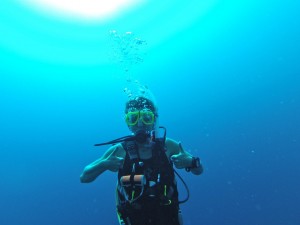Back in September, we were taken to a site called Admiral’s Aquarium for our first snorkel of the semester. There wasn’t much of a current, but there was more than we were used to, and the swell was pretty big – as in every time you lifted your head to try and listen to the intern showing you around, you got a face full of water. My first night snorkel here was at a site called Shark Alley, which is really quite spectacular, except that we had no idea what we were doing and ended up on a shallow shelf of coral, turning it into a mind game that went along the lines of “if I suck my stomach in enough I won’t hit those corals.” My bazillionth snorkel here had both big swells and shallow reef – and I was carrying a laboratory.
Okay, not quite, but it was our second time collecting data for directed research and we hadn’t gotten used to the equipment yet. Directed research projects started last week, and the resource management professor and three other students and I are studying the proliferation of the invasive lionfish, Pterois volitans, at various sites near South Caicos. When we go out for a research dives or snorkels, we carry underwater slates, pencils, transect tapes, clip weights for the end of the transect tapes, and plastic T-bars with centimeter increments.
Besides the fact that it means I get to dive between four and eleven times a week, this is a fascinating and relevant research project because it involves the world’s most ecologically-harmful marine invasion ever. You know the stereotypical look-at-this-reef-and-all-the-pretty-fish-isn’t-nature-amazing type of picture? A lionfish will eat pretty much every single fish in that picture as long as it can open its mouth wide enough. They eat up to 6% of their body weight per day (even as a rower, I can’t eat nine pounds of food a day); not only that, but native reef fishes haven’t figured out an effective defense mechanism to avoid their predation, and the only fish that eat them are the hugely-overfished grouper. Also, they’re venomous.
The environmental morals of the story: don’t let your cool aquarium fish out into the ocean because they will take over everything, and use reusable water bottles instead of buying those single-use plastic ones. That latter part was absolutely unrelated to lionfish, just something I thought I’d throw in there after a recent lecture on pollution and marine debris (remember that campaign on campus last spring with the plastic jellyfish hanging in the SUB?). I’ll get down from my soapbox now.

